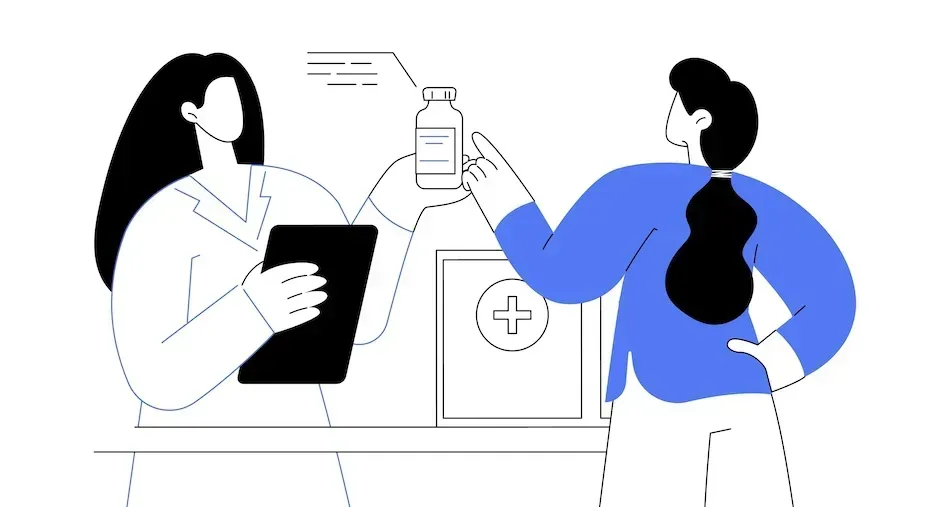What are the Treatments for CLL?
Chronic lymphocytic leukemia (CLL) is no longer treated with chemotherapy. As of the mid-2000s, modern targeted therapies have become the new standard for managing the disease. Targeted therapy means that the medicines target cancer cells, leaving most healthy cells alone. We will discuss the top specialist-recommended CLL treatments below in more detail.
Please note that consulting a CLL specialist is always a good idea regarding your treatment plan, even if that plan is implemented by your local cancer doctor (oncologist). Click here to find a CLL specialist.
When Can I Start CLL Treatment?
CLL treatment starts when the disease starts causing problems, not only at the time of diagnosis. This can often be anxiety-provoking for people with CLL. The reason behind waiting to start treatment is that specialists have found that your length and health-related quality of life are not impacted by waiting.
Reasons to start CLL treatment include:
- You have major CLL symptoms like:
- Drenching night sweats
- Fever with no infection
- Extreme fatigue
- Unintended weight loss of at least 10% of your body weight within 6 months
- CLL is causing one or more of your organs to stop working properly
- The size of your spleen or lymph nodes is increasing quickly and causing you pain
- CLL is causing your blood cell counts to decrease such as red blood cells and platelets
- You have autoimmune cytopenia (your body is destroying its own blood cells) and treatment with steroids is not working
- You can enroll in a clinical trial
What are the CLL Treatments?
If you find that it’s nearing the time to start treatment, the list below outlines the top-recommended options by CLL specialists. There’s no one right choice, your CLL specialist can go into more detail about which may be a better match for your personal situation. Factors that influence your treatment decision may come down to areas like what your insurance will approve and your personal preference. These targeted therapies work well for the majority of people with CLL, even CLL types that were considered to be high-risk in the chemotherapy era like del(17p)/TP53 mutation.
Also, almost all individuals living with CLL will try several of these treatments over the course of their lives. This is because CLL cells can become intolerant to one type of therapy after several years, causing the need to change to another. As of 2024, CLL is a disease that is managed over time and, unfortunately, is not necessarily eliminated with one therapy forever. We understand this can be difficult and are here to help support you in your journey.
- Venetoclax + Obinutuzumab Combination
- Venetoclax (Venclexta, AbbVie):
- A BCL-2 inhibitor taken as a daily pill over the course of 1 year and then stopped for first-time therapy. Taken for two years as a second-line therapy (often referred to as a fixed-duration treatment). Venetoclax kills CLL cells and some healthy B-cells, leaving the majority of other healthy cells alone. Many patients experience multiple years in remission after treatment. CLL cells usually come back after that period. Click here for more specifics about how long, on average, you’ll be in remission after venetoclax treatment based on your CLL type. This doesn’t necessarily mean you’ll need treatment right after your remission ends, but rather, you would watch for signs and symptoms of CLL to come up again that indicate needing to start a new therapy. You could repeat venetoclax treatment; you may also choose another CLL medicine outlined below.
- Obinutuzumab (Gazyva, Genentech):
- A monoclonal antibody that is administered at several intervals over the course of the first 6 months by intravenous infusion. You may have a reaction with the first infusion, this is very common and can often be managed with supportive medicines. Tell your healthcare team if you notice anything abnormal, at which they’ll stop the infusion, administer supportive medicines, give your body a break, and then try the infusion again. After the break, most people’s bodies have adjusted to the antibody and will accept the infusion with no further issues. If you continue to have non-manageable infusion-related reactions, your doctor may decide not to proceed with this treatment for your safety.
- Notes
- Starting venetoclax requires some more attention and visits with your healthcare team at first while your body adjusts to the medicine. However, the further you progress on therapy, often the easier it gets, and many patients enjoy multiple years in remission after their one-year treatment period.
- Venetoclax is FDA-approved with obinutuzumab as a first-time CLL treatment. If this is a treatment you want as a second-line therapy, a different antibody called rituximab is FDA-approved. CLL specialists recommend trying to get your insurance to request obinutuzumab over rituximab because it’s proven to be better.
- Check out some of our articles about venetoclax:
- Venetoclax for CLL: Treatment Options and Patient Outcomes
- How Effective is Venetoclax After a BTK Inhibitor for CLL?
- Cost of Venetoclax + Obinutuzumab vs BTK Inhibitors for First-time Treated CLL Patients on Medicare
- Janice’s CLL Treatment Experience with Venclexta + Gazyva
- Understanding Your CLL Treatment Options: Fixed-Duration vs. Continuous-Duration Therapies
- Venetoclax (Venclexta, AbbVie):
- BTK Inhibitors
- BTK inhibitors started with ibrutinib (Imbruvica, Janssen Biotech) and have improved to newer versions called acalabrutinib (Calquence, AstraZeneca) and zanubrutinib (Brukinsa, BeiGene). The newer versions are advised over ibrutinib because they have fewer heart-related side effects. They are pills taken daily for an indefinite period of time. They are often referred to as continuous-duration therapies. They help delay the progression of CLL, slowly reducing the amount of the disease over time, not necessarily killing it all at once. They are effective for the majority of people with CLL to keep the disease at bay for several years, extending your length of life. If you experience a notable side effect, your doctor may suggest reducing the dose before trying to switch to another therapy. Although easy to take, after several years, the CLL cells may become intolerant to the BTK inhibitor, and you may need to choose a different CLL therapy like venetoclax. Click here to read about how long, on average, BTK inhibitors work based on your CLL type.
- Note: Obinutuzumab infusions are often recommended to be combined with acalabrutinib to improve treatment effectiveness. Also, it is hopefully anticipated that a fixed-duration treatment combination of a BTK inhibitor and venetoclax will be FDA-approved soon.
- Check out some of our articles about BTK inhibitors:
- What are BTK Inhibitors for CLL?
- Making the Choice in CLL: Acalabrutinib or Zanubrutinib
- Reducing Ibrutinib Dose Impacts Time to Next CLL Treatment
- Cost of Venetoclax + Obinutuzumab vs BTK Inhibitors for First-time Treated CLL Patients on Medicare
- Understanding Your CLL Treatment Options: Fixed-Duration vs. Continuous-Duration Therapies
- BTK inhibitors started with ibrutinib (Imbruvica, Janssen Biotech) and have improved to newer versions called acalabrutinib (Calquence, AstraZeneca) and zanubrutinib (Brukinsa, BeiGene). The newer versions are advised over ibrutinib because they have fewer heart-related side effects. They are pills taken daily for an indefinite period of time. They are often referred to as continuous-duration therapies. They help delay the progression of CLL, slowly reducing the amount of the disease over time, not necessarily killing it all at once. They are effective for the majority of people with CLL to keep the disease at bay for several years, extending your length of life. If you experience a notable side effect, your doctor may suggest reducing the dose before trying to switch to another therapy. Although easy to take, after several years, the CLL cells may become intolerant to the BTK inhibitor, and you may need to choose a different CLL therapy like venetoclax. Click here to read about how long, on average, BTK inhibitors work based on your CLL type.
Relapsed/Refractory CLL Treatment Options
If you have previously taken and become intolerant to venetoclax and a BTK inhibitor, there are other treatment options. Venetoclax and BTK inhibitors are the standard of care for CLL and should be tried first. However, if you have experienced relapsed/refractory disease meaning CLL came back after or became intolerant to a prior therapy, the below treatments are recommended:
- FDA-approved relapsed/refractory CLL treatment options
- Pirtobrutinib (Jaypirca, Eli Lilly): A non-covalent BTK inhibitor that binds to the CLL cells in a different way than covalent BTK inhibitors, allowing the medicine to inhibit CLL progression despite prior resistance to covalent BTK inhibitors.
- Note: Pirtobrutinib works for about a year for relapsed/refractory CLL. It has fewer side effects than covalent BTK inhibitors. It is being evaluated in clinical trials like Dr. Inhye Ahn's study if it could be of better use as a first-time CLL treatment.
- Liso-cel (Breyanzi, BMS): A CAR T-cell therapy that works by re-engineering your T-cells to more effectively kill CLL cells.
- Note: There was a lot of excitement about CAR T-cell therapy for CLL that, unfortunately, for the brand liso-cel, the one-time infusion only works well for about 20% of CLL patients because of T-cell exhaustion. An area being explored to decrease T-cell exhaustion is creating CAR T-cells from healthy donors or "Off-the-Shelf CAR T" instead of using a person with CLL's own T-cells.
- Allogeneic stem cell transplant: You receive an infusion of donor stem cells (cells capable of forming all other types of blood cells). Because of its side effects, this treatment is often considered a last resort for people with CLL.
- Pirtobrutinib (Jaypirca, Eli Lilly): A non-covalent BTK inhibitor that binds to the CLL cells in a different way than covalent BTK inhibitors, allowing the medicine to inhibit CLL progression despite prior resistance to covalent BTK inhibitors.
- Relapsed/refractory CLL treatment options in clinical trials
- BTK degraders: They target and remove the BTK protein on CLL cells, allowing for treatment effectiveness despite prior BTK inhibitor intolerance.
- Sonrotoclax (BeiGene): A second-generation BCL-2 inhibitor.
- Bispecific antibodies: Immunotherapy that brings cancer-killing T-cells near CLL cells to kill them.
HealthTree Foundation looks forward to continued advances in CLL medicine. Stay tuned to our news website for weekly updates on various CLL topics.
Need CLL Financial Support?
If you are starting CLL treatment and need financial support, click here to review HealthTree’s CLL financial resource page and here for more insight from our financial program manager Diahanna Vallentine.
Learn More About CLL
Stay tuned for CLL updates with the HealthTree News articles, where we share patient stories, treatment advances, and practical updates to help you be informed.
Sources:
Chronic lymphocytic leukemia (CLL) is no longer treated with chemotherapy. As of the mid-2000s, modern targeted therapies have become the new standard for managing the disease. Targeted therapy means that the medicines target cancer cells, leaving most healthy cells alone. We will discuss the top specialist-recommended CLL treatments below in more detail.
Please note that consulting a CLL specialist is always a good idea regarding your treatment plan, even if that plan is implemented by your local cancer doctor (oncologist). Click here to find a CLL specialist.
When Can I Start CLL Treatment?
CLL treatment starts when the disease starts causing problems, not only at the time of diagnosis. This can often be anxiety-provoking for people with CLL. The reason behind waiting to start treatment is that specialists have found that your length and health-related quality of life are not impacted by waiting.
Reasons to start CLL treatment include:
- You have major CLL symptoms like:
- Drenching night sweats
- Fever with no infection
- Extreme fatigue
- Unintended weight loss of at least 10% of your body weight within 6 months
- CLL is causing one or more of your organs to stop working properly
- The size of your spleen or lymph nodes is increasing quickly and causing you pain
- CLL is causing your blood cell counts to decrease such as red blood cells and platelets
- You have autoimmune cytopenia (your body is destroying its own blood cells) and treatment with steroids is not working
- You can enroll in a clinical trial
What are the CLL Treatments?
If you find that it’s nearing the time to start treatment, the list below outlines the top-recommended options by CLL specialists. There’s no one right choice, your CLL specialist can go into more detail about which may be a better match for your personal situation. Factors that influence your treatment decision may come down to areas like what your insurance will approve and your personal preference. These targeted therapies work well for the majority of people with CLL, even CLL types that were considered to be high-risk in the chemotherapy era like del(17p)/TP53 mutation.
Also, almost all individuals living with CLL will try several of these treatments over the course of their lives. This is because CLL cells can become intolerant to one type of therapy after several years, causing the need to change to another. As of 2024, CLL is a disease that is managed over time and, unfortunately, is not necessarily eliminated with one therapy forever. We understand this can be difficult and are here to help support you in your journey.
- Venetoclax + Obinutuzumab Combination
- Venetoclax (Venclexta, AbbVie):
- A BCL-2 inhibitor taken as a daily pill over the course of 1 year and then stopped for first-time therapy. Taken for two years as a second-line therapy (often referred to as a fixed-duration treatment). Venetoclax kills CLL cells and some healthy B-cells, leaving the majority of other healthy cells alone. Many patients experience multiple years in remission after treatment. CLL cells usually come back after that period. Click here for more specifics about how long, on average, you’ll be in remission after venetoclax treatment based on your CLL type. This doesn’t necessarily mean you’ll need treatment right after your remission ends, but rather, you would watch for signs and symptoms of CLL to come up again that indicate needing to start a new therapy. You could repeat venetoclax treatment; you may also choose another CLL medicine outlined below.
- Obinutuzumab (Gazyva, Genentech):
- A monoclonal antibody that is administered at several intervals over the course of the first 6 months by intravenous infusion. You may have a reaction with the first infusion, this is very common and can often be managed with supportive medicines. Tell your healthcare team if you notice anything abnormal, at which they’ll stop the infusion, administer supportive medicines, give your body a break, and then try the infusion again. After the break, most people’s bodies have adjusted to the antibody and will accept the infusion with no further issues. If you continue to have non-manageable infusion-related reactions, your doctor may decide not to proceed with this treatment for your safety.
- Notes
- Starting venetoclax requires some more attention and visits with your healthcare team at first while your body adjusts to the medicine. However, the further you progress on therapy, often the easier it gets, and many patients enjoy multiple years in remission after their one-year treatment period.
- Venetoclax is FDA-approved with obinutuzumab as a first-time CLL treatment. If this is a treatment you want as a second-line therapy, a different antibody called rituximab is FDA-approved. CLL specialists recommend trying to get your insurance to request obinutuzumab over rituximab because it’s proven to be better.
- Check out some of our articles about venetoclax:
- Venetoclax for CLL: Treatment Options and Patient Outcomes
- How Effective is Venetoclax After a BTK Inhibitor for CLL?
- Cost of Venetoclax + Obinutuzumab vs BTK Inhibitors for First-time Treated CLL Patients on Medicare
- Janice’s CLL Treatment Experience with Venclexta + Gazyva
- Understanding Your CLL Treatment Options: Fixed-Duration vs. Continuous-Duration Therapies
- Venetoclax (Venclexta, AbbVie):
- BTK Inhibitors
- BTK inhibitors started with ibrutinib (Imbruvica, Janssen Biotech) and have improved to newer versions called acalabrutinib (Calquence, AstraZeneca) and zanubrutinib (Brukinsa, BeiGene). The newer versions are advised over ibrutinib because they have fewer heart-related side effects. They are pills taken daily for an indefinite period of time. They are often referred to as continuous-duration therapies. They help delay the progression of CLL, slowly reducing the amount of the disease over time, not necessarily killing it all at once. They are effective for the majority of people with CLL to keep the disease at bay for several years, extending your length of life. If you experience a notable side effect, your doctor may suggest reducing the dose before trying to switch to another therapy. Although easy to take, after several years, the CLL cells may become intolerant to the BTK inhibitor, and you may need to choose a different CLL therapy like venetoclax. Click here to read about how long, on average, BTK inhibitors work based on your CLL type.
- Note: Obinutuzumab infusions are often recommended to be combined with acalabrutinib to improve treatment effectiveness. Also, it is hopefully anticipated that a fixed-duration treatment combination of a BTK inhibitor and venetoclax will be FDA-approved soon.
- Check out some of our articles about BTK inhibitors:
- What are BTK Inhibitors for CLL?
- Making the Choice in CLL: Acalabrutinib or Zanubrutinib
- Reducing Ibrutinib Dose Impacts Time to Next CLL Treatment
- Cost of Venetoclax + Obinutuzumab vs BTK Inhibitors for First-time Treated CLL Patients on Medicare
- Understanding Your CLL Treatment Options: Fixed-Duration vs. Continuous-Duration Therapies
- BTK inhibitors started with ibrutinib (Imbruvica, Janssen Biotech) and have improved to newer versions called acalabrutinib (Calquence, AstraZeneca) and zanubrutinib (Brukinsa, BeiGene). The newer versions are advised over ibrutinib because they have fewer heart-related side effects. They are pills taken daily for an indefinite period of time. They are often referred to as continuous-duration therapies. They help delay the progression of CLL, slowly reducing the amount of the disease over time, not necessarily killing it all at once. They are effective for the majority of people with CLL to keep the disease at bay for several years, extending your length of life. If you experience a notable side effect, your doctor may suggest reducing the dose before trying to switch to another therapy. Although easy to take, after several years, the CLL cells may become intolerant to the BTK inhibitor, and you may need to choose a different CLL therapy like venetoclax. Click here to read about how long, on average, BTK inhibitors work based on your CLL type.
Relapsed/Refractory CLL Treatment Options
If you have previously taken and become intolerant to venetoclax and a BTK inhibitor, there are other treatment options. Venetoclax and BTK inhibitors are the standard of care for CLL and should be tried first. However, if you have experienced relapsed/refractory disease meaning CLL came back after or became intolerant to a prior therapy, the below treatments are recommended:
- FDA-approved relapsed/refractory CLL treatment options
- Pirtobrutinib (Jaypirca, Eli Lilly): A non-covalent BTK inhibitor that binds to the CLL cells in a different way than covalent BTK inhibitors, allowing the medicine to inhibit CLL progression despite prior resistance to covalent BTK inhibitors.
- Note: Pirtobrutinib works for about a year for relapsed/refractory CLL. It has fewer side effects than covalent BTK inhibitors. It is being evaluated in clinical trials like Dr. Inhye Ahn's study if it could be of better use as a first-time CLL treatment.
- Liso-cel (Breyanzi, BMS): A CAR T-cell therapy that works by re-engineering your T-cells to more effectively kill CLL cells.
- Note: There was a lot of excitement about CAR T-cell therapy for CLL that, unfortunately, for the brand liso-cel, the one-time infusion only works well for about 20% of CLL patients because of T-cell exhaustion. An area being explored to decrease T-cell exhaustion is creating CAR T-cells from healthy donors or "Off-the-Shelf CAR T" instead of using a person with CLL's own T-cells.
- Allogeneic stem cell transplant: You receive an infusion of donor stem cells (cells capable of forming all other types of blood cells). Because of its side effects, this treatment is often considered a last resort for people with CLL.
- Pirtobrutinib (Jaypirca, Eli Lilly): A non-covalent BTK inhibitor that binds to the CLL cells in a different way than covalent BTK inhibitors, allowing the medicine to inhibit CLL progression despite prior resistance to covalent BTK inhibitors.
- Relapsed/refractory CLL treatment options in clinical trials
- BTK degraders: They target and remove the BTK protein on CLL cells, allowing for treatment effectiveness despite prior BTK inhibitor intolerance.
- Sonrotoclax (BeiGene): A second-generation BCL-2 inhibitor.
- Bispecific antibodies: Immunotherapy that brings cancer-killing T-cells near CLL cells to kill them.
HealthTree Foundation looks forward to continued advances in CLL medicine. Stay tuned to our news website for weekly updates on various CLL topics.
Need CLL Financial Support?
If you are starting CLL treatment and need financial support, click here to review HealthTree’s CLL financial resource page and here for more insight from our financial program manager Diahanna Vallentine.
Learn More About CLL
Stay tuned for CLL updates with the HealthTree News articles, where we share patient stories, treatment advances, and practical updates to help you be informed.
Sources:
Trending Articles
Get the Latest Chronic Lymphocytic Leukemia Updates, Delivered to You.
By subscribing to the HealthTree newsletter, you'll receive the latest research, treatment updates, and expert insights to help you navigate your health.
Together we care.
Together we cure.
3x Faster.




